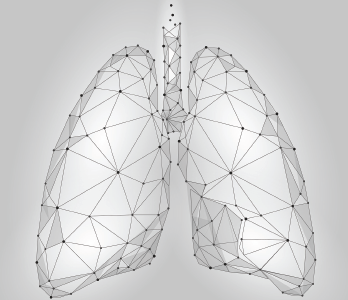
LuckyStep / shutterstock.com
CHICAGO—About 30 years ago, pulmonary arterial hypertension (PAH) and interstitial lung disease (ILD) began to outpace renal crisis as the main causes of death in scleroderma (SSc). But treating these lung complications has proved vexing for clinicians.
There is no easy way to predict who will develop PAH. There is no telltale antibody and no clear pattern of SSc symptoms that presage the condition, so screening is important, said Janet Pope, MD, MPH, chair of rheumatology at St. Joseph’s Health Care in London, Ontario, Canada.
“There’s a chance of us preventing worsening and helping the patients [with] this lethal complication—we can prolong survival,” Dr. Pope said. “We can’t predict who will develop PAH, and it is common in scleroderma, occurring in approximately 15% of patients. That’s why we screen.”
PAH Treatment
Older age of onset, long-standing SSc, severe ILD, a drop in diffusing capacity (DLCO) and possibly elevated uric acid (although this remains anecdotal) are associated with increased PAH, according to Dr. Pope. “The bottom line: It’s like [rheumatoid arthritis]. Use multiple drugs, start treatment earlier, prevent worsening by front-end loading and use different combinations of drugs,” she said. Treatment includes supportive care such as exercise, endothelin receptor agonists, phosphodiesterase type 5 (PDE5) inhibitors, prostacylins and the soluble guanylate cyclase, riociguat.
Dr. Pope cautioned that PDE5 inhibitors and riociguat are contraindicated as a combination, but combinations of the other strategies are acceptable, and bring the best results.
“That is really the trend,” she said. “And that’s a very expensive thing. But we do prevent clinical worsening and we’ve improved survival.” She noted that the survival rate for PAH in scleroderma has doubled twice during her time in practice.
ILD Treatment
As for ILD, pulmonologists sometimes say screening isn’t worth it because therapies don’t usually bring enough benefit. But there are differences of opinion, Dr. Pope said. “You can ask three people and get two answers, and the third answer is someone on the fence.”
In a survey study of practice patterns in which she participated, scleroderma experts said ILD deemed clinically relevant is mostly treated initially with mycophenolate mofetil, with cyclophosphamide as the most common second-line treatment. Then they move on to rituximab or agents undergoing testing in clinical trials, Dr. Pope said.1
“But they’re also saying that usually they don’t even try corticosteroids,” she said. “If patients are corticosteroid responsive, that’s a good prognosis, but it’s highly unlikely.” Those who do try prednisone tend to start with 1 mg/kg for a month, and they rapidly stop if there is no response, but if there is improvement in cough or dyspnea, they often use a maintenance dose of 10 mg/day or so.
When the time does come to treat, there is some guidance.
Based on her reading of the literature and her own clinical impression, a worse prognosis in ILD is seen when extensive disease appears on high-resolution CT, when fibrosis is present, with hypoxia or cough, when severe restriction appears on pulmonary function tests and, of course, when PAH is present as well.
Still, there is “no agreement on who to treat,” she said.
When the time does come to treat, there is some guidance. A recent phase 2 trial with tocilizumab enrolled patients with mostly mild to moderate disease, and it showed less worsening of lung function than placebo.2
A single-center study in Greece found that treatment with rituximab resulted in better lung function (i.e., total lung capacity and diffusing capacity) and skin scores compared with placebo.3 But Dr. Pope added that not all published case series have shown a benefit from rituximab in these patients, so it is “not our home run.”
A study published earlier this year found that mycophenolate mofetil was not inferior to cyclophosphamide in SSc-ILD patients.4 And the IPF treatments nintedanib, pomalidomide and perfenidone are now being closely assessed in ILD associated with scleroderma, Dr. Pope said.5,6,7
“We don’t know about the IPF treatments,” she said. “They’re being trialed for safety. … Now they’re looking at some of them for efficacy.”
Thomas R. Collins is a freelance writer living in South Florida.
References
- Fernández-Codina A, Walker K, Pope J, et al. Real-life treatment strategies for systemic sclerosis according to experts. Annals of the Rheumatic Diseases. 2017;76:629.
- Khanna D, Denton CP, Jahreis A, et al. Safety and efficacy of subcutaneous tocilizumab in adults with systemic sclerosis (faSScinate): A phase 2, randomised, controlled trial. Lancet. 2016 Jun 25;387(10038):2630–2640.
- Daoussis D, Liossis SN, Tsamandas AC, et al. Effect of long-term treatment with rituximab on pulmonary function and skin fibrosis in patients with diffuse systemic sclerosis. Clin Exp Rheumatol. 2012 Mar–Apr;30(2 Suppl 71):S17–S22.
- Tashkin DP, Roth MD, Clements PJ, et al. Mycophenolate mofetil versus oral cyclophosphamide in scleroderma-related interstitial lung disease (SLS II): A randomised controlled, double-blind, parallel group trial. Lancet Respir Med. 2016 Sep;4(9):708–719.
- Hsu VM, Denton CP, Domsic RT, et al. Pomalidomide in patients with interstitial lung disease due to systemic sclerosis: A phase II, multicenter, randomized, double-blind, placebo-controlled, parallel-group study. J Rheumatol. 2018 Mar;45(3):405–410.
- Distler O, Brown KK, Distler JHW, et al. Design of a randomised, placebo-controlled clinical trial of nintedanib in patients with systemic sclerosis-associated interstitial lung disease (SENSCIS™). Clin Exp Rheumatol. 2017 Sep–Oct;35 Suppl 106(4):75–81. Epub 2017 Jun 29.
- Khanna D, Albera C, Fischer A, et al. An open-label, phase II study of the safety and tolerability of pirfenidone in patients with scleroderma-associated interstitial lung disease: The LOTUSS trial. J Rheumatol. 2016 Sep;43(9):1672–1679.
